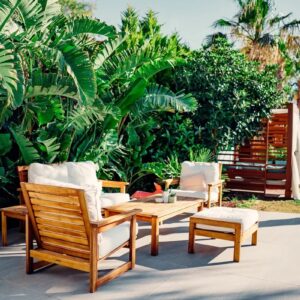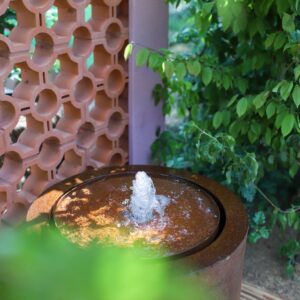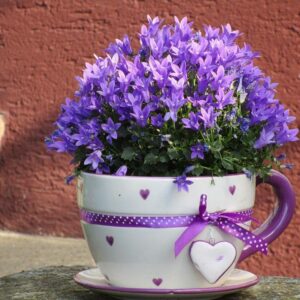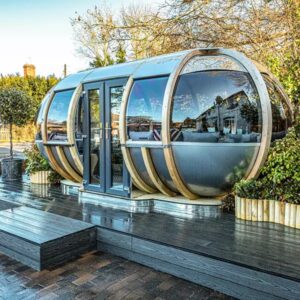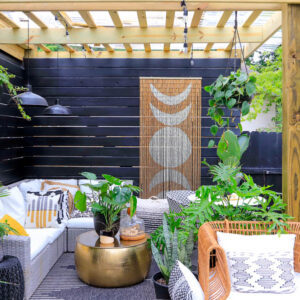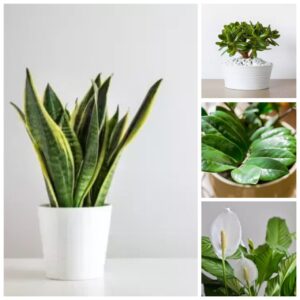‘Dortmund’ Climbing Rose
:max_bytes(150000):strip_icc():format(webp)/2415402_5clim_0049-1-e010f5b6262f4bb09194f6a6fb155f62.jpg)
- Botanical Name: Rosa ‘Dortmund’
- Sun Exposure: Full
- Soil Type: Well-drained, Moist
- Soil pH: Slightly Acidic (6.0 to 6.5)
‘Dortmund’ climbing rose features abundant, single red blooms with striking white centers and yellow stamens. Its clusters of flowers and glossy leaves put on a showy garden display. This vigorous plant reaches 15 to 30 feet if it’s not pruned. Wear gloves when you do—its sturdy thorns are legendary. This vine is deciduous, and it grows throughout the South.
Bougainvillea
:max_bytes(150000):strip_icc():format(webp)/gettyimages-683777197-1-f837a125b5e6422ca994cfb09e94783e.jpg)
- Botanical Name: Bougainvillea
- Sun Exposure: Full
- Soil Type: Well-drained
- Soil pH: Slightly Acidic (5.5 to 6.0)
You can’t go wrong with the bougainvilleas if you want a stunning visual impact. Native to Central and South America, they grow well in Florida, South Texas, and along the Gulf and South Atlantic coasts. And with the introduction of varieties bought in full bloom and grown in containers, more Southerners can enjoy these plants than ever before. They are relatively drought-tolerant and sun-loving. Bougainvilleas are suited for growing against walls or on sturdy fences, trellises, or arbors.
Clematis
:max_bytes(150000):strip_icc():format(webp)/gettyimages-1034192336-1-e184ea27dc264147ba3ec8a8fd936696.jpg)
- Botanical Name: Clematis spp.
- Sun Exposure: Full
- Soil Type: Well-drained, Moist
- Soil pH: Acidic, Neutral (6.5 to 7.0)
The showy clematis is not demanding but does have a few specific requirements. Plant the vine next to a trellis, tree trunk, or open framework to give stems support for twining. Provide rich, loose, fast-draining soil, and add generous quantities of organic matter such as decomposed ground bark. A clematis vine needs constant moisture and nutrients to make the great rush of growth, so apply a complete liquid fertilizer monthly during the growing season.
American Wisteria
:max_bytes(150000):strip_icc():format(webp)/gettyimages-1029064570-1-bb184554ad8b4e94a164afb527b96115.jpg)
- Botanical Name: Wisteria frutescens
- Sun Exposure: Full
- Soil Type: Well-drained, Moist
- Soil pH: Acidic, Neutral (6.8 to 7.2)
Perfect for smaller spaces, this gorgeous twining vine is smaller, less aggressive, and grows at about a third of the rate of Asian wisteria. This selection blooms at an early age, with lovely, lightly fragrant racemes gracefully falling downward. The vines are sturdy and robust. Use in containers for the porch or patio, train up an arbor or trellis, or use as a small free-standing tree.
Trumpet Creeper
:max_bytes(150000):strip_icc():format(webp)/gettyimages-508393073-1-1013c6039e5445dbad3875bd840d1f9d.jpg)
- Botanical Name: Campsis radicans
- Sun Exposure: Full, Partial
- Soil Type: Well-drained, Moist
- Soil pH: Acidic, Alkaline (6.0 to 8.0)
Native to eastern Texas and the southeastern U.S., the trumpet creeper, or trumpet vine, is a robust, easy-to-grow, hard-working vine. It grows in any soil and is very drought-tolerant, preferring full sun to partial shade. The trumpet creeper climbs by aerial roots to heights of 30 to 40 feet and will grow in the most challenging spots, covering an ugly wall, fence, or other structure in one growing season. The beautiful red summer flowers will attract hummingbirds to your garden.
Purple Passionflower (Maypop)
:max_bytes(150000):strip_icc():format(webp)/gettyimages-826011326-1-3605300836114351bb3c06bb6a683f79.jpg)
- Botanical Name: Passaflora incarnata
- Sun Exposure: Full, Partial
- Soil Type: Well-drained
- Soil pH: Acidic, Neutral (6.5 to 7.5)
With exotic-looking summer flowers, the purple passionflower hosts the larvae of the zebra longwing butterfly and feeds numerous pollinators. It climbs by tendrils to a height of 10 to 18 feet, preferring full sun or partial shade and medium to dry, well-drained soil. Fragrant flowers bloom in summer. Fleshy, egg-shaped, edible fruits called maypops appear in July and mature to a yellowish color in the fall.
Star Jasmine
:max_bytes(150000):strip_icc():format(webp)/2415402_5climgettyimages-499479577-b5da30a1e5514e17a466bae31349a98a.jpg)
- Botanical Name: Trachelospermum jasminoides
- Sun Exposure: Full, Partial
- Soil Type: Well-drained, Moist
- Soil pH: Acidic, Neutral (6.0 to 7.0)
When star jasmine blooms in late spring and early summer, a profusion of white, starlike flowers on its evergreen foliage perfumes the entire garden. Plant this vine near a patio or entry to enjoy its fragrance. Train it above doorways and windows and against walls. It’s not hardy in the Upper South.
Carolina Jessamine
:max_bytes(150000):strip_icc():format(webp)/2415401_5clim_0032-36e94e93698b47348a89d5df5d2c8ab3.jpg)
- Botanical Name: Gelsemium sempervirens
- Sun Exposure: Full, Partial
- Soil Type: Well-drained, Moist
- Soil pH: Acidic, Neutral (6.0 to 7.5)
In early spring, Carolina jessamine, adorned with fragrant, bell-shaped blossoms, is excellent for training on structures—its thin, pliable stems don’t damage them. It grows and covers very quickly and is suitable for screening. Deer don’t like it. It’s an evergreen and not hardy in the Upper South.
Hybrid Mandevillas
:max_bytes(150000):strip_icc():format(webp)/2415402_5clim_f5412_4857-1-7150380b701d4bb38d2271689f9bc1e1.jpg)
- Botanical Name: Mandevilla sp.
- Sun Exposure: Full, Partial
- Soil Type: Well-drained, Moist
- Soil pH: Acidic, Neutral (6.6 to 7.8)
Hybrid Mandevillas feature glossy evergreen foliage and large, spectacular red, pink, or white flowers that appear nonstop in warm weather. The Sun Parasol series has vining and bush-type plants, so check the label. They are fast growers. They’re not hardy to frost.
Morning Glories
:max_bytes(150000):strip_icc():format(webp)/2415402_5clim_-bells-1-fb1985f34aaa4530a6d53a8b2ff17144.jpg)
- Botanical Name: Ipomoea tricolor
- Sun Exposure: Full
- Soil Type: Well-drained
- Soil pH: Slightly Acidic, Neutral (6.0 to 6.8)
A packet of seeds is all you need to blanket a bower with blue, purple, red, pink, or white morning glories. Plant these flowers in the spring. Each flower lasts only one day, but new ones open up every morning in summer and fall. This annual vine grows throughout the South.
Crossvine
:max_bytes(150000):strip_icc():format(webp)/2415402_5clim_3-1-68aa76cd03a04ca09a429c7f2d33967f.jpg)
- Botanical Name: Bignonia capreolata
- Sun Exposure: Full
- Soil Type: Well-drained
- Soil pH: Acidic, Alkaline (6.6 to 8.0)
Crossvine is a rugged, adaptable, carefree Southern native. Trumpet-shaped blooms of orange or red decorate evergreen leaves in mid-spring. This vine climbs any surface. ‘Tangerine Beauty’ (shown) flaunts abundant orange flowers with yellow throats. This climber grows throughout the South.
Trumpet Honeysuckle
:max_bytes(150000):strip_icc():format(webp)/ga_87fd4390c465ab93_spcms_1-1-14929779d9114754828587f9718317e4.jpg)
- Botanical Name: Lonicera sempervirens
- Sun Exposure: Full, Partial
- Soil Type: Sandy, Clay, Loamy, Well-drained
- Soil pH: Acidic, Neutral, Alkaline (6.5 to 8.0)
Trumpet honeysuckle is a deciduous climbing vine that shows off from late spring through summer and can climb up to 20 feet tall. This Southern favorite attracts hummingbirds with its showy, trumpet-shaped blooms (ranging from golden yellow to deep scarlet) and red berries. Try planting ‘Major Wheeler,’ a mildew-resistant selection with yellow colors, or ‘Cedar Lane,’ a quick-growing selection with deep red flowers. Trumpet honeysuckle grows best in Zones US, MS, LS, and CS (USDA 6 to 9) and prefers full sun to part shade and regular water.
Climbing Hydrangea
:max_bytes(150000):strip_icc():format(webp)/gettyimages-977811192-2000-7e69ea7622a349f38b0f7fbccad6c8f6.jpg)
- Botanical Name: Hydrangeaceae anomala petiolaris
- Sun Exposure: Full, Partial
- Soil Type: Well-drained, Moist
- Soil pH: Acidic (5.0 to 6.5)
Did you know this beloved Southern showstopper is a climber too? Climbing hydrangeas perform best in Zones US, MS, and LS (USDA 6 to 8). These rapid growers can reach 60 feet tall. In late spring to summer, clusters of wide, white flowers bloom on the vines. If your climbing hydrangea doesn’t bloom during the first season, don’t worry—it can sometimes take ten years for these vines to produce flowers. In fall, the green leaves fade into yellow.
Viewed using Just Read
Report an error
